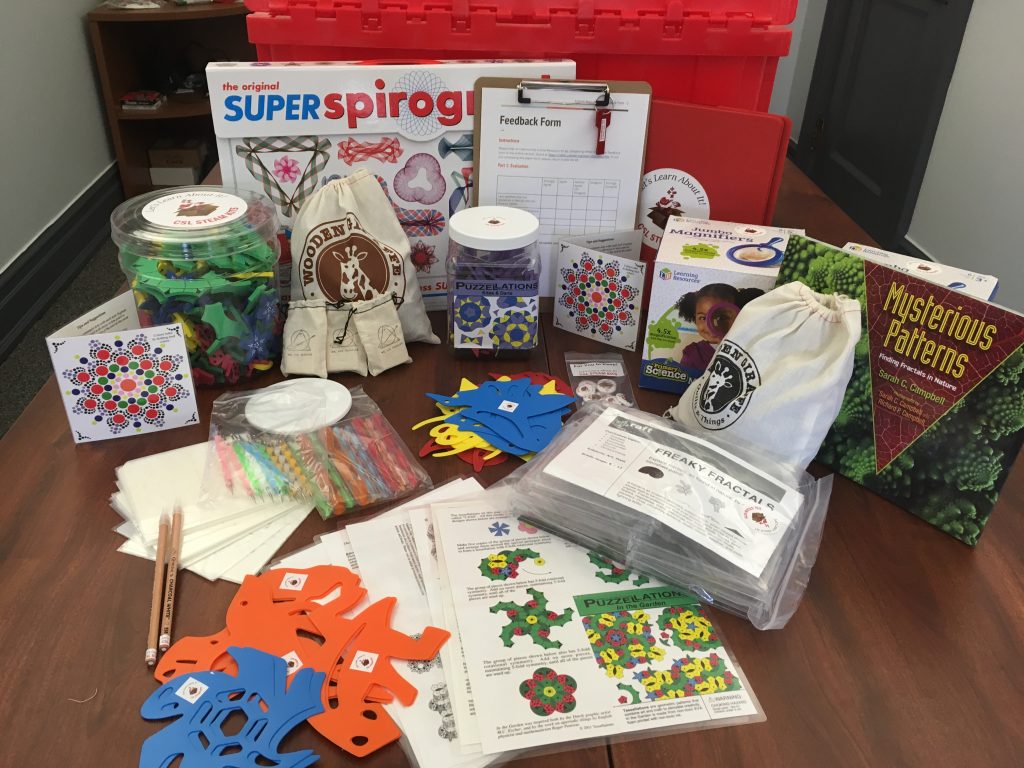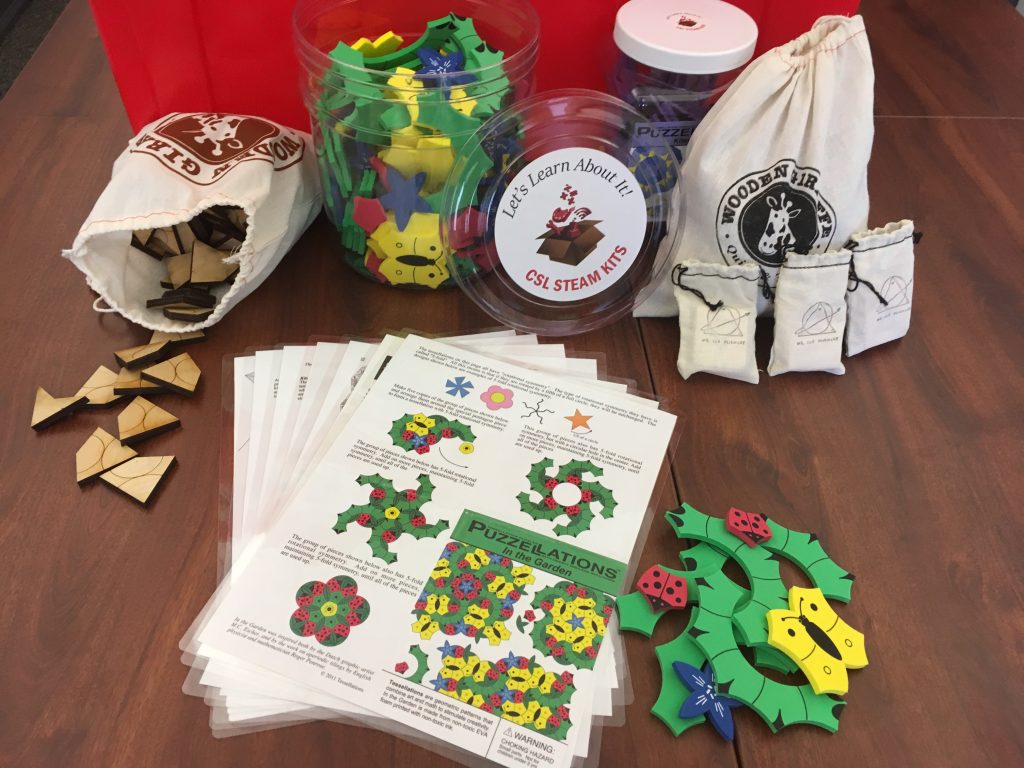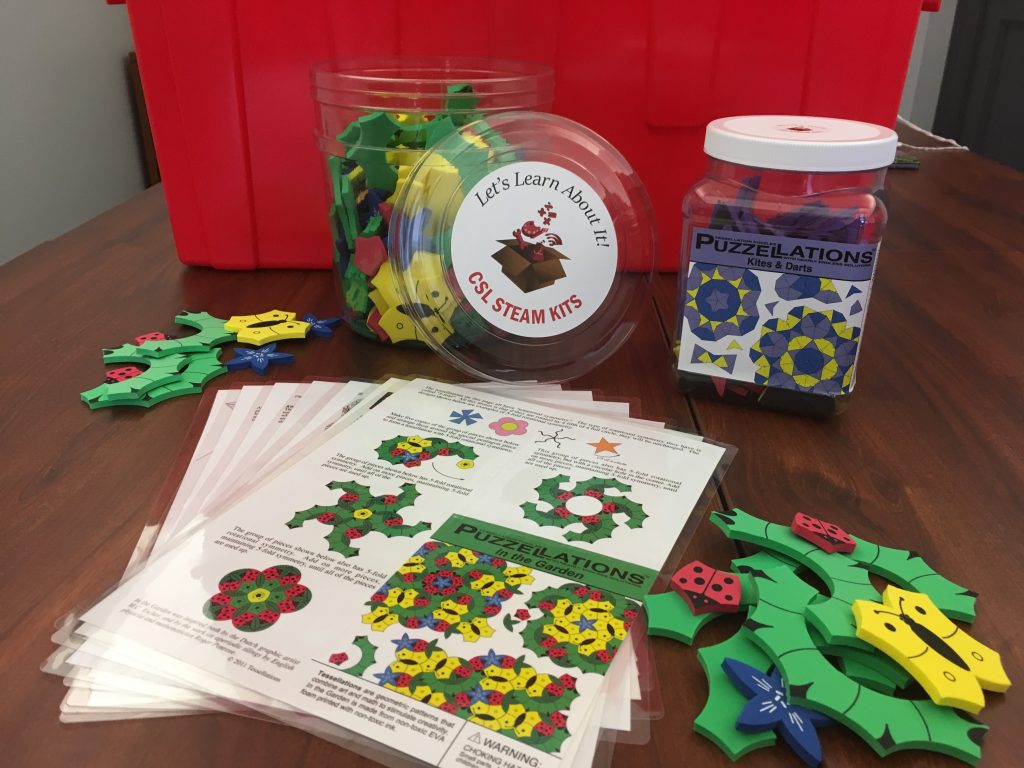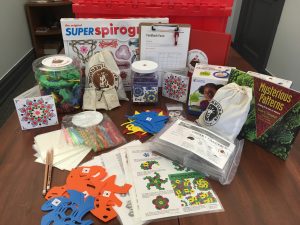


Anyone with an interest in art or math will enjoy learning about the magic of fractals! Even the non-mathematical will have fun with the beautiful imagery and the fascinating, mind-bending concepts and patterns (which require next to no math to understand).
Contents
- 1 1” red resource kit binder
- 1 clipboard containing contents list and feedback form
- 12 jumbo magnifiers
- 1 book: Mysterious Fractals (ISBN 9781620916278)
- 28 white mandala dot painting stencils
- 2 sets of Dazazzle Mandala Dotting Tools, which include:
- 2 plastic paint trays
- 2 Charcoal White #558 pencils
- 10 acrylic & steel ball stylus tools, various colors and sizes
- 12 acrylic rods, various colors and sizes
- 24 Tessellations animal stencils, assorted designs
- 2 wooden tile sets containing 352 pieces:
- Penrose set #1 (in cloth drawstring Wooden Giraffe bag):
- 108 kites with half-circle patterns
- 68 darts with half-circle patterns
- Penrose set #2 (in cloth drawstring Wooden Giraffe bag):
- 8 decagons
- 12 elongated hexagons
- 12 bowties
- 12 pentagons
- 16 darts
- 20 kites
- 22 elongated rhombuses
- 32 diamonds (parallelograms)
- 22 obtuse triangles
- 14 medium isosceles triangles
- 12 small isosceles triangles
- 2 tiny isosceles triangles
- Penrose set #1 (in cloth drawstring Wooden Giraffe bag):
- Super Spirograph 75-Piece Jumbo Kit (50th Anniversary Edition)
- 1 bin of Puzzellations “In the Garden,” 231 foam tiles
- 1 bin of Puzzellations “Kites & Darts,” 105 magnet-backed foam tiles
- 3 rubber stamps:
- 1 Mandelbrot stamp
- 1 Sierpinski triangle stamp
- Koch snowflake stamp
- 20 Arteza craft acrylic paints
- White paper
Audience
Recommended for ages 5 and up.
Other Resources
WEBSITES
- Fractal Foundation’s Fractivities sheet
- Colorado Academic Standards
- http://www.cde.state.co.us/standardsandinstruction/2009standards
- Plenty of useful information if you’re trying to partner with a local school or with student-age library users. Check out the Online Sortable Tool and try searching “patterns” within the Mathematics or Science sections.
- Denver Art Museum > Hayagriva Mandala
- https://denverartmuseum.org/edu/object/hayagriva-sand-mandala
- Visit the site to see a sand mandala gifted to DAM by the Seraje Monastery in Tibet. There are excellent teaching resources available at the link, including a detailed lesson plan, videos of the mandala’s creation, and a printable coloring page.
- MegaMenger Project
- http://megamenger.com
- The Menger Sponge is a mind-bending 3D fractal shape, and this site supported by the University of London has free downloadable instructions on creating a Menger Sponge using business cards. There are lots of pictures of completed projects worldwide, plus templates to create your own “cladding” to give your creation more layers. Check out the Activities & Programs for more ideas.
- RAFT: Resource Area for Teaching > Freaky Fractals
- http://raft.education/activity_kits/freaky-fractals/
- Purchase preassembled kits from RAFT to use in your program (membership required), or simply download their idea sheet (also available in this kit). Links to various teaching standards can be found here.
- TopIslamic.com > Islamic Art for Kids 15 Colouring Pages
- https://topislamic.com/islamic-art-for-kids-download/
- Free coloring pages showing traditional Islamic art, provided by blogger and teacher Salah Ad Deen.
- University of Kansas School of Education > Fractals for Fun: Teaching Kids Patterns in Nature
- A great introductory site that has gathered plenty of useful links to descriptions, images, games, and other activities.
- https://educationonline.ku.edu/articles/teaching-kids-patterns-in-nature
VIDEOS
- Doodling In Math: Infinity Elephants: Khan Academy
- https://www.khanacademy.org/math/math-for-fun-and-glory/vi-hart/doodling-in-math/v/doodling-in-math-class-infinity-elephants
- A challenge for math class doodlers! This video is part of a mesmerizing series demonstrating doodling in math, and it’s also funny and clever.
- Fractals and the Art of Roughness: Benoit Mandelbrot TED2010
- https://www.ted.com/talks/benoit_mandelbrot_fractals_the_art_of_roughness
- Fractals discussed by the mathematician who first named them.
- The Fractals at the Heart of African Designs: Ron Eglash TEDGlobal 2007
- https://www.ted.com/talks/ron_eglash_on_african_fractals
- Ethno-mathematician Eglash, author of the book African Fractals (Rutgers UP, 2002) talks about his research into African design.
- Koch Snowflake Fractal: Khan Academy
- https://www.khanacademy.org/math/geometry-home/geometry-volume-surface-area/koch-snowflake/v/koch-snowflake-fractal
- For those who want to know the math, Sal Khan explains it in this short video series. Learn how “A shape that has an infinite perimeter but finite area” is mathematically possible.
- Stories About Nature: Michael Frame at TEDxYale 2013
- https://www.youtube.com/watch?v=bz8NJ7ZVXwQ
- Lots of great visual examples of fractal designs.
- What Is a Fractal (And What Are They Good For?): Khan Academy/MIT
- https://www.khanacademy.org/partner-content/mit-k12/mit-math/v/what-is-a-fractal-and-what-are-they-good-for
- A concise introduction that talks about how fractals have been used in technology like antennas, and demonstrates a Koch snowflake.
APPS
- ➽ Frax – Immersive Fractals – Review in the Smithsonian Magazine: “A New App Turns Fractals Into Ornate Art”. Short URL: https://bit.ly/2EtqohC – A $.99 app built on the Mandelbrot and Julia set equations, it allows users to play and be immersed in the art of fractals. For IOS.
- Mandala Maker: symmetry doodle – Draw and color intricate mandala patterns with this app for Android and IOS.
BOOKS
- Fractals: A Very Short Introduction. Kenneth Falconer. Oxford University Press, 2013. 9780199675982.
- The introduction is accessible and has good drawings of fractals and the motifs/generators that make them up. Your patrons who want to go beyond the Khan Academy math videos will appreciate the deeper math Falconer includes.
- Fractals: A Graphic Guide. Nigel Lesmoir-Gordon, Will Rood & Ralph Edney. Icon Books, 2009.
- An accessible introduction that will give people who want to know a little more just the right amount of information about what fractals are, how they were first described, and how they are used today.
- Mysterious Patterns: Finding Fractals in Nature. Sarah C. Campbell and Richard Campbell. Boyds Mills Press, 2014. ISBN 9781620916278.
- Included in kit. If you only read one book about fractals, this one will give you just the right start, with lots of pictures to illustrate the ideas.
- Patterns in Nature: Why the Natural World Looks the Way It Does. Philip Ball. University of Chicago Press, 2016. ISBN 9780226332420
- Gorgeous, full-color photographs fill this book. Only chapter 2 is about fractals, and the rest of the book is about other types of patterns found in nature. Accessible and eye-catching.
YOUTUBE
There are more videos on this topic than can be included here – many include mesmerizing imagery that will take you down the rabbit hole for hours.
If your patrons have dipped their toes in and can’t wait to learn more, below are a set of internet search terms that will turn up beautiful images and fascinating mathematical history.
Search terms for inspiration:
- Cantor set
- Devil’s staircase (Cantor set)
- Eulerian path/Eulerian circuit
- Fournier fractal (shows that an infinite universe need not be equally bright in all directions, if it has a fractal structure – answer to Olbers’ Paradox)
- Indra’s net
- Julia set/Fatou set (couldn’t be adequately visualized until computers caught up – though the math was described during WWI by Gaston Julia and Pierre Fatou)
- Lichtenberg figure
- Lorenz attractor/system
- Mandelbrot set
- Pascal’s triangle (contains the Sierpinski gasket – color the odd numbers black, the even ones white to make the fractal easy to see)
- Peano curve
- Penrose tiling (see also: Darb-i-Imam shrine in Isfahan, Iran, built in 1453)
- Saturn’s rings
- Symmetry in nature
- Tessellation
- Turing patterns
- Viscous fingering

